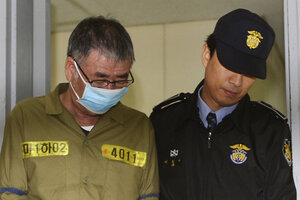S. Korean prosecutors seek death penalty for ferry captain
Prosecutors are also demanding life sentences for three key ferry crew members and 30-year sentences against 11 others.

Lee Joon-seok, the captain of the sunken South Korean ferry Sewol, left, arrives at Gwangju District Court in Gwangju, South Korea, Monday, Oct. 27, 2014. South Korean prosecutors demanded the death penalty for the captain of a doomed ferry and life sentences to three key crew members, arguing Monday they are responsible for April’s sinking that killed more than 300 people, news reports said.
Park Chul-hong, Yonhap/AP
Seoul, South Korea
South Korean prosecutors on Monday demanded the death penalty for the captain of a ferry that sank earlier this year, killing more than 300 people, blaming his negligence and failure to rescue passengers in need for the massive loss of life, a court official and news reports said.
Prosecutors also requested life sentences for three other key crew members during a trial at the Gwangju District Court in southern South Korea, a court official said on condition of anonymity because he wasn't authorized to speak to the media about the sentence requests. He said prosecutors asked for sentences of up to 30 years for 11 other crew members.
The 15 crew members tasked with the ship's navigation were among the first people rescued from the ship when it began badly listing, a source of the fierce public anger directed at them. Most of those who died in the disaster were students from a single high school who were en route from Incheon, west of Seoul, to the resort island of Jeju on April 16.
"The captain made no rescue efforts after issuing a broadcast asking passengers to stay in their cabins. ... He didn't organize any rescue operations after leaving the ship," Yonhap news agency quoted prosecutors as saying during the trial on Monday. Other South Korean media also carried the comments, but the court official said he couldn't confirm them.
Capt. Lee Joon-seok and the three key crew members — a first mate, a second mate and the chief engineer — were indicted in May on homicide charges. Eleven other crew members were indicted on less serious charges.
Court officials have said the court will issue verdicts on the 15 crew members in November.
The death penalty is the maximum legal sentence in South Korea, but the country has a de facto moratorium on capital punishment and has not executed anyone since December 1997. South Korean courts, however, still occasionally issue death sentences.
Kook Joung-don, a lawyer for the relatives of the victims, said they were "angry" because they thought the overall requested punishment for the crew members was not strong enough. But Seoul-based lawyer Kwon Young-gook said he was skeptical about whether authorities were trying to make the crew members bear the entire responsibility for the disaster.
The sinking, one of South Korea's deadliest disasters in decades, caused nationwide grief and fury, with authorities blaming overloading of cargo, improper storage, untimely rescue efforts and other negligence for the incident.
More than six months after the sinking, the bodies of 294 people have been recovered, while 10 others have not been found. A total of 476 people were aboard the ship, with 172 of them rescued.
Lee has apologized for abandoning the passengers, but said he didn't know his action would lead to so many deaths.
Many student survivors have said they were repeatedly ordered over a loudspeaker to stay on the sinking ship and that they didn't remember any evacuation order being given before they helped each other flee the vessel.
Lee has said he issued an evacuation order for passengers. But he initially told reporters days after his arrest that he withheld the evacuation order because rescuers had yet to arrive and he feared for the passengers' safety in the cold, swift waters.
The defense in the trial has denied any collusion among the crew members, saying they were confused, injured and panicked.

